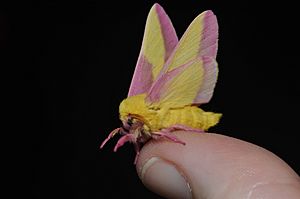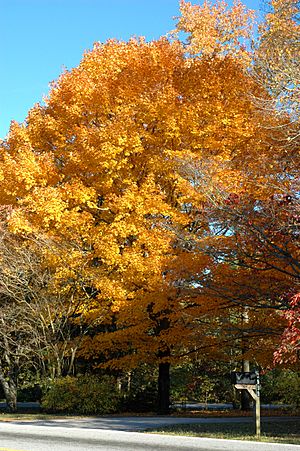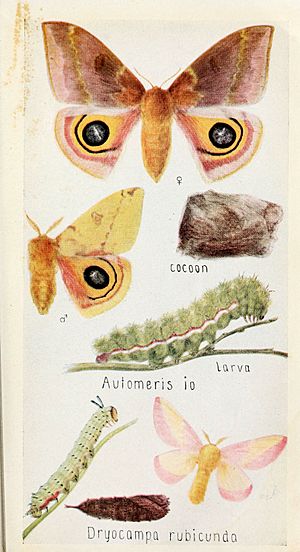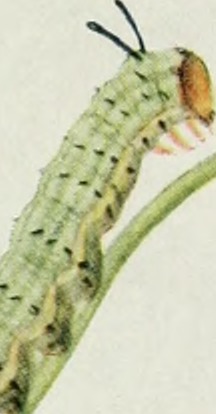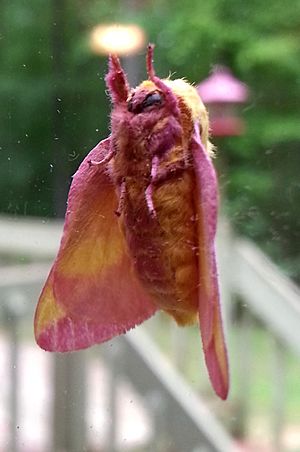Rosy maple moth facts for kids
Quick facts for kids Rosy Maple Moth |
|
|---|---|
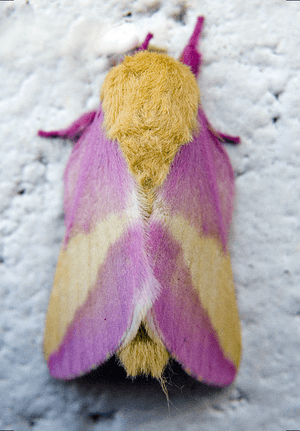 |
|
| Scientific classification |
The rosy maple moth, also known as Dryocampa rubicunda, is a small, colorful moth found in North America. It belongs to a family of moths called Saturniidae, which are also known as great silk moths. A scientist named Johan Christian Fabricius first studied and described this moth in 1793. These moths are easy to spot because of their fuzzy bodies and bright pink and yellow colors. The exact shades can change, from creamy white to bright pink or yellow. Male moths have bushier antennae than females. They use these special antennae to find female moths for mating.
As their name suggests, rosy maple moths love maple trees. Adult female moths lay their small, yellow, oval-shaped eggs in groups of 10 to 40. They usually place them on the underside of maple leaves. The baby caterpillars that hatch from these eggs are called greenstriped mapleworms. They mostly eat the leaves of maple trees, especially red maple, silver maple, and sugar maple trees. If there are many caterpillars, they can eat all the leaves off a tree. This usually doesn't hurt the tree permanently, but it can make it look a bit bare. Interestingly, adult rosy maple moths do not eat at all!
Contents
What Does It Look Like?
The rosy maple moth is the smallest type of silk moth. Male moths have wings that spread about 3.2 to 4.4 centimeters (1.25 to 1.75 inches) wide. Females are a bit larger, with wings spanning 3.8 to 5 centimeters (1.5 to 2 inches). You can tell them apart by their unique pink and yellow colors, which can vary a lot. They have reddish-pink legs and antennae. Their bodies and back wings are yellow. Their front wings are pink with a yellow band shaped like a triangle across the middle.
Where Do They Live?
Rosy maple moths live across the eastern United States and nearby parts of Canada. In Canada, you can find them in southern areas like Ontario, Quebec, New Brunswick, Nova Scotia, and Prince Edward Island. Their home range stretches south along the Atlantic coast all the way to Dade County, Florida. To the west, they live from eastern Texas up through Minnesota.
Their Home: Forests and Yards
You can find rosy maple moths in temperate deciduous forests. These are forests where trees lose their leaves in the fall. They also live in suburban areas and city parks. Their common name comes from the fact that they mostly live on maple trees. These include red maples (Acer rubrum), sugar maples (Acer saccharum), silver maples (Acer saccharinum), and box elder maples (Acer negundo). Sometimes, they can also be found on oak trees, especially turkey oaks (Quercus laevis), if they are near maple trees.
What They Eat
Rosy maple moths prefer to lay their eggs on maple trees, and sometimes on nearby oak trees. The caterpillars stay on the same tree where they hatched. They mostly eat the underside of maple or oak leaves. When they are very young, the caterpillars eat together in groups. But as they grow bigger, usually after their third or fourth stage (called an instar), they start to eat by themselves. These caterpillars eat the entire leaf blade. A single caterpillar can eat several leaves! If there are many greenstriped mapleworms, they can eat all the leaves off a tree. This damage is usually not permanent, and the leaves will grow back. Remember, adult rosy maple moths do not eat at all.
Reproduction
Laying Eggs
Female rosy maple moths lay their eggs about one day after mating. During this time, the eggs are safe inside the female's body. After laying her eggs, the female moth leaves. She doesn't take care of her babies. Females usually lay between 150 to 200 eggs. They place them in groups of 10 to 40 on the underside of maple leaves, and sometimes oak leaves. Most females only lay eggs once. However, in warmer southern areas, they can lay eggs up to three times a year. Egg laying usually happens in the warmer months, often peaking in July. The exact timing depends on where they live. In northern areas, one group of eggs is laid between May and August. Further south, two groups are laid between April and September. In Florida, three groups of eggs can be laid between March and October.
Social Life
Caterpillars live and eat together in groups until they reach their fourth stage of growth. After that, they become solitary, meaning they live alone. Adult rosy maple moths are mostly solitary too, except when they are mating.
Life Cycle
A rosy maple moth typically lives for about two to nine months. From hatching to becoming an adult, they go through five stages of growth. If a moth lives longer, it usually spends a lot of that time as a pupa during the winter months.
Eggs
Eggs are laid about 24 hours after mating. They are oval-shaped and about 1.4 millimeters wide. They have a thin, smooth, yellow shell. The eggs hatch after about ten days to two weeks. Once the caterpillar hatches, a clear eggshell is left behind.
Caterpillar
Rosy maple moth larvae are called greenstriped mapleworms. They go through five stages of growth before becoming adults. Their colors and eating habits change during these stages. When they are young, they have relatively large black heads and pale yellow-green bodies with faint green stripes. They have two big dark-green or black bumps on their second body segment. They also have three rows of smaller spines on each side of their body.
They shed their skin, or molt, several times as they grow. Their first molt happens about 6 to 11 days after hatching. The second molt is around 12 days after hatching, and the third is about 19 days after hatching. In later stages, their black head becomes smaller compared to their body. The stripes on their body get darker and turn reddish. In their final stage, their head becomes yellow, then bright red. Their body is yellow-green with stripes that can be white, green, or black. The two prominent horns on their second body segment are joined by two rows of short spines along their sides. When fully grown, the caterpillars are about 2 inches long. They live and eat together until their fourth stage, but then they become solitary.
Pupa
After about a month, the full-grown caterpillars crawl down to the bottom of their host tree. They then turn into a pupa in shallow underground chambers. The pupae are very dark, long, and have small spines. The pupa ends in a small, forked point. This pupa stage lasts at least two weeks, and sometimes through the entire winter. If the moths pupate over winter, they spend most of their lives in this pupa stage. When the adult moth (called an imago) emerges, its wings are small. It has to pump fluid into them to make them expand so it can fly.
Adult
Adult rosy maple moths are easy to recognize by their bright pink and yellow colors. However, the exact shades can vary a lot. Both male and female moths have a wingspan of 32–55 millimeters. Their bodies are fuzzy, usually yellow on top and pink underneath, but they can also be cream or white. Their legs and antennae are also pink. The front wings can be yellow to white with different amounts of pink along the edges. There's even a special type, called the alba subspecies, found in Missouri, which is completely white or white with very faint pink marks.
Predators
Birds are the main predators of rosy maple moths and their caterpillars. These birds include blue jays, black-capped chickadees, and tufted titmice. The moth's bright colors might be a way to protect themselves. They might trick predators into thinking they are poisonous and not good to eat. Surprisingly, the moth's colors also help it blend in with maple seed cases, acting as a form of camouflage.
Mating
Rosy maple moths show sexual dimorphism, which means males and females look different. Male rosy maple moths have narrower and less rounded wings. Female moths have simple antennae, but males have antennae that look like combs on both sides. These special antennae help males sense chemicals called pheromones released by females when it's time to mate. Moths become ready to mate when they are 2 to 9 months old. Mating happens at night. Females release pheromones to attract males. The eggs are fertilized inside the female. Females lay their eggs 24 hours after mating. These moths are polygyandrous. This means that females can find a new male to mate with each time they lay eggs during the breeding season, especially in warmer regions where they lay multiple groups of eggs.
|
See also
 In Spanish: Polilla rosada del arce para niños
In Spanish: Polilla rosada del arce para niños


